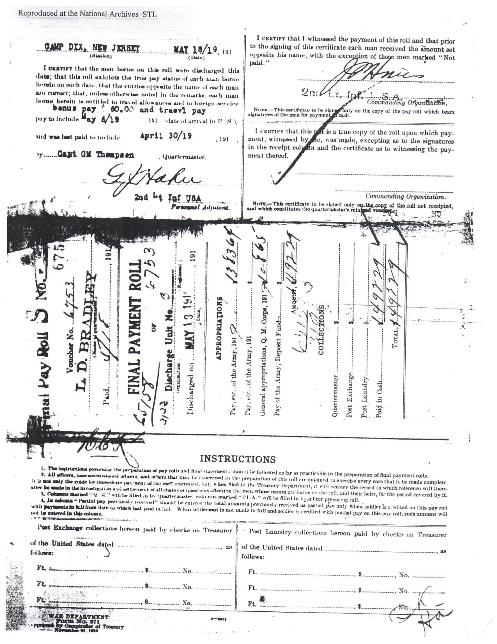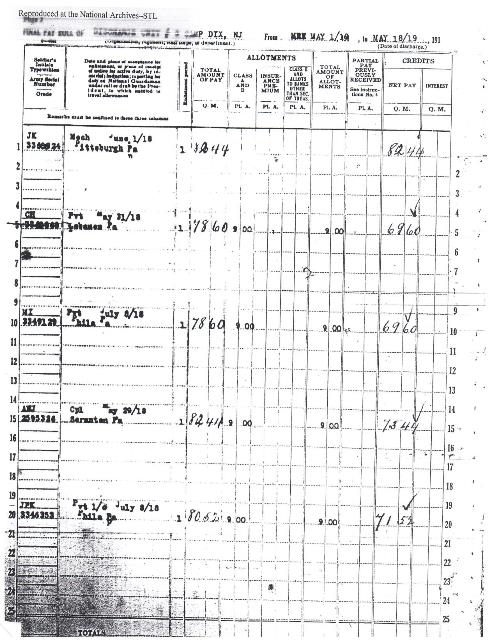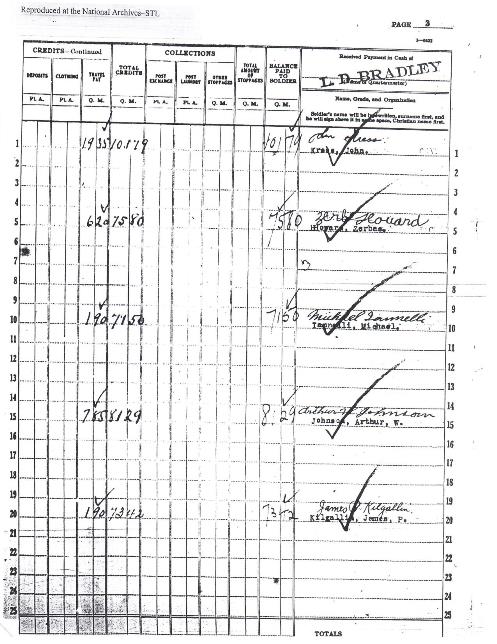by michaelstrauss | Dec 6, 2017 | 01 What's New, Military |
Official Military Personnel Files (OMPFs) are 20th and 21st U.S. military records for conflicts such as WWI, WWII, and beyond. OMPFs are packed with great genealogy clues, but millions were destroyed by a 1973 fire. Here’s how to find what records still remain, and what you might find if your relative’s OMPF went up in flames.

What are Official Military Personnel Files?
If your ancestor served in the U.S. military during the 20th or 21st century, related service records are called Official Military Personnel Files (OMPFs), or sometimes “201 files,” named after the brown file folder that holds them. These are available for each of the military branches: Army, Navy, Air Force, Marines, and Coast Guard. They are generally held at the National Personnel Record Center in St. Louis, Missouri. (Exceptions for veterans discharged since 1995 may be at other government offices.)
According to the National Archives, Official Military Personnel Files are “primarily an administrative record, containing information about the subject’s service history such as: date and type of enlistment/appointment; duty stations and assignments; training, qualifications, performance; awards and decorations received; disciplinary actions; insurance; emergency data; administrative remarks; date and type of separation/discharge/retirement; and other personnel actions.” The level of detail in complete files make them invaluable genealogical records.
How to Access Official Military Personnel Files
On July 12, 1973, a disastrous fire ravaged the building where the OMPFs were housed. Between 16 and 18 million personnel files were destroyed or damaged; these affected names alphabetically after James E. Hubbard. It was a serious loss for two particular branches of the military:
- Army Personnel discharged 1912-1960: 80% Loss (4 in every 5 files).
- Air Force Personnel discharged 1947-1964: 75% Loss (3 in every 4 files). (Remember: the Air Force wasn’t officially organized until September 14, 1947. Before this date Air Force records were part of the United States Army Air Corps, then part of the U.S. Army.)
The Navy, Marines, and Coast Guard records were largely unaffected by the fire.
Surviving OMPFs and reconstructed records relating to destroyed files are considered to be archival (or open to researchers without restrictions) 62 years after the date of discharge. This is a rolling date, so discharge dates of 1955 and earlier are open to the public. In 2018, that date will change to 1956, and so on. More recent records are considered non-archival and subject to restrictions; only the veteran or next-of-kin have full access to the files.
You can access Official Military Personnel Files in three ways:
1. Go to St. Louis in person. Appointments are recommended, as research space is limited. Click here for information about requesting an appointment, the availability of records, copy fees, and hours of operation.
2. Employ an independent researcher. Click here for the National Archives’ list of researchers.
3. Request records by mail. Here’s a link to the online portal for requesting these records; here’s a direct link to the PDF format of Standard Form 180, which you can print and mail in.
My grandfather’s OMPF: What survived?
I didn’t fully grasp how many records were lost in the fire in 1973 until I ordered a record of one of my family members. When my grandfather Richard Keller was a small child, he received postcards from his great Uncle Zerbe Howard: I remember him. He died when I was 10 years old. Zerbe served during World War I and was a resident of Lebanon, PA.

I have in my possession the 2 postcards sent my grandfather that listed his name, rank, and military unit. I ordered his file which took several months, and when it arrived I expected it to be full of information. Unfortunately, his file was completely destroyed.
The only reconstructed records located were three pages recording him on a final payment roll with other men from his unit. Here’s an image of that record, which seems so sparse compared to what that original OMPF may have contained:



This final payment roll from Camp Dix, New Jersey is dated from April 1918 to May of 1919. It reveals that the soldiers on this roll were discharged on this date, that they were entitled to travel allowance and foreign service bonus pay of $60 and what their individual payments were. Zerbe even appears to have signed the record in his own scrawling handwriting. While it may be discouraging to have such limited information available due to the 1973 fire, it’s still worth pulling records such as these to track your military ancestors.
The National Personnel Record Center now has other records available to researchers to help fill in some of the gaps. For example, the Army filed Morning Reports, organized by unit. I also found local records in Pennsylvania that were not in the hands of the federal government. Listen to the free Genealogy Gems Podcast or come back to this blog for future tips on researching your 20th-century U.S. relatives’ military service.
Looking for 19th century US military records?
 If your ancestor served in the military during the 1800s or earlier, you’ll want to look for his Compiled Military Service Records at the National Archives in Washington, DC. The exact dates for each military branch vary in years accordingly. Click here to learn more about those.
If your ancestor served in the military during the 1800s or earlier, you’ll want to look for his Compiled Military Service Records at the National Archives in Washington, DC. The exact dates for each military branch vary in years accordingly. Click here to learn more about those.
For more ongoing training in tracing your military ancestors, tune in to the free Genealogy Gems Podcastand listen for my segment, “Military Minutes.”
by Lisa Cooke | Nov 22, 2023 | 01 What's New, Family Reunions, Personal History, Preservation |
In this free video, you’ll discover three important steps you can take right now to capture and preserve your family traditions for generations to come from my wonderful friend and colleague Gena Philibert-Ortega. Happy Thanksgiving!
Watch Now:
Resources:
Download the ad-free Show Notes cheat sheet for this video here. (Premium Membership required.)
Show Notes: Three steps to preserve your Thanksgiving traditions
Thanksgiving, in my opinion, is a family history holiday. It’s one where families gather, where we bring out family heirlooms, and where we talk where we share memories. So, it’s a good time to think about your Thanksgiving traditions, write them down, preserve them, and share them. So, let’s talk a little bit about how to do that.
#1 Ask
I have my memories of Thanksgiving from when I was a kid, when I was a young adult, and then later when I was married, and had small children versus older children. However, my kids have their own memories, and grandparents have their memories too. So, now’s the time to ask about those and write them down. Those memories might have to do with food, material culture, which I’ll define in just a second, or they may have to do with events.
Food:
What are the recipes that you use at Thanksgiving?
How does Thanksgiving food change as you grow older? Or as the roles switch?
Who cooks, and how has that changed over time?
Who’s there with you enjoying the meal and the holiday?
These are things that you can interview family members or yourself and write down.
Material Culture and Thanksgiving:
Material culture simply means stuff. So what stuff is used to put on Thanksgiving? At my house, that means the special tablecloth and the China both mine and my grandmother’s.
What do you bring out to serve Thanksgiving? It might be special dinnerware, or special serving pieces. It might be aprons to wear, or special linens.
What kinds of things are on the little kids table?
What is brought out and talked about and how has that changed over the years?
What do you use for special occasions like Thanksgiving? Do you go out to eat?
What events are associated with Thanksgiving for your family? Some families like to play a little flag football, some families watch the Macy’s Thanksgiving parade.
Whatever it is for your family, write that down, talk about it, explain what it is. Remember, we’re preserving memories that our children and grandchildren will read in the future. They may not understand what that event is. So, make sure you describe it.
#2 Document
What are some of the ways you can document your traditions? Well, you can do it with photographs. You can share photos from the past Thanksgiving. Have everybody bring the photos they have. You can even create a Thanksgiving album for your family. You can gather photos, photos from recent Thanksgivings, and even take photos of this Thanksgiving. You can ask family members to write their memories. You could also interview family members and create a video.
Paper or computer programs:
For example, maybe you could put together recipe cards and hand them out at Thanksgiving. Have everybody write their favorite recipes and then duplicate them and pass them out.
Family cookbook:
There are certainly many different programs online that you can use to create one yourself or that you can send to a specialized cookbook publisher.
Tablecloth:
Get a white tablecloth and bring out waterproof markers and ask family members to write their name. Write the date write events that have happened in the year. Write down memories if they want for little kids have them trace their hands, have them sign their name the best they can write their ages down. You can use that year after year, or you can preserve it for one specific year.
#3 Share
A lot of us have the habit of gathering information and then not really sharing it. But sharing it is what makes sure that things are preserved and ensures that it’s preserved that it goes down the generations. And it’s a good idea to have copies in case some are lost. Sharing is important. So how do we do that?
Physically:
We can do that by creating physical items like:
- photo albums
- flash drives (create duplicate flash drives and hand them out to the family.)
- post things on social media, like a family Facebook page, or maybe a Pinterest board, or even your online family tree on Ancestry or FamilySearch
- the cloud – where family members can download what they need when they need it. And you can continue to add family members over the years. And that might be done in a cloud program like Dropbox or Google Drive.
Preserve Your Thanksgiving Traditions Today
There are all kinds of ways that you can share Thanksgiving traditions and memories with other family members. Do what’s best for you what’s easiest for you, and what gets the information out there sooner rather than later. Thanksgiving is a special time and it’s something that we may all look forward to maybe because of the food or the family. I hope that you take some time this Thanksgiving to preserve your family memories. Happy Thanksgiving!
Resources:
Download the ad-free Show Notes cheat sheet for this video here. (Premium Membership required.)
About My Special Guest Presenter: Gena Philibert-Ortega
Gena Philibert-Ortega is an author, researcher, and instructor whose focus is genealogy, social and women’s history. She holds a Master’s degree in Interdisciplinary Studies (Psychology and Women’s Studies) & a Master’s degree in Religion. Her published works include 3 books, numerous articles published in magazines and online, & Tracing Female Ancestors (Moorshead Publishing). She is the editor of the Utah Genealogical Association’s magazine, Crossroads. Her writings can also be found on the GenealogyBank blog. She has presented to diverse groups including the National Genealogical Society Conference, Alberta Genealogical Society Conference, Geo-Literary Society, & the Legacy Family Tree Webinar series. Her research projects include Sowerby’s British Mineralogy: Its Influence on Martha Proby and Others in the Scientific Community during the 19th Century for the Gemological Institute of America, as well as genealogical research for the first season of PBS’s Genealogy Roadshow & the Travel Channel’s Follow Your Past. Her current research includes women’s repatriation and citizenship in the 20th century, foodways and community in fundraising cookbooks, & women’s material culture.





 If your ancestor served in the military during the 1800s or earlier, you’ll want to look for his Compiled Military Service Records at the National Archives in Washington, DC. The exact dates for each military branch vary in years accordingly. Click here to learn more about those.
If your ancestor served in the military during the 1800s or earlier, you’ll want to look for his Compiled Military Service Records at the National Archives in Washington, DC. The exact dates for each military branch vary in years accordingly. Click here to learn more about those.